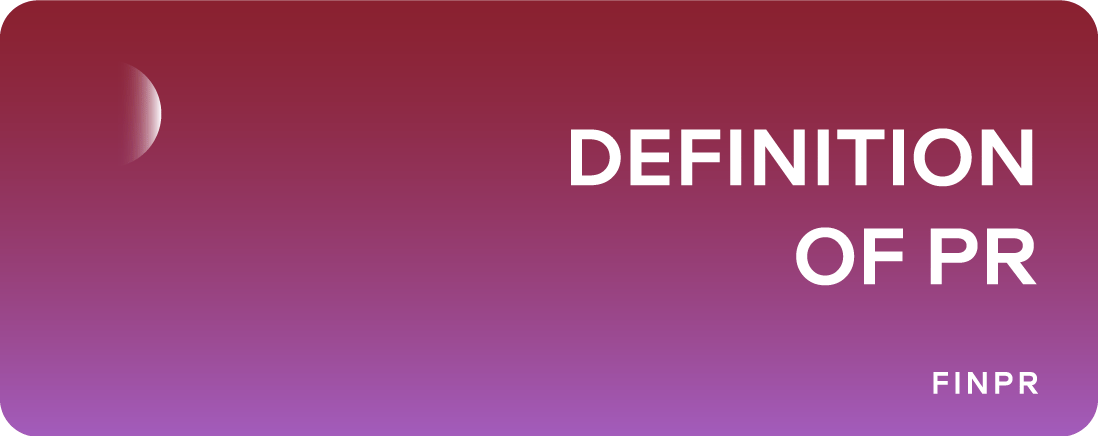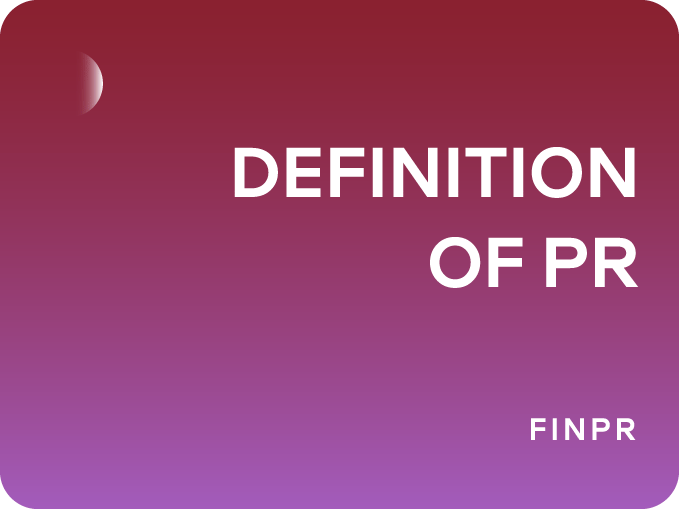
Have you heard anything about examples of successful PR campaigns such as the PEPE token? In an age where information travels at the speed of light and reputations with internal relations can be made or destroyed in an instant, the role of positive PR has never been greater.
What exactly is Public Relations? Is it just another term for marketing or advertising? Or is it something deeper, community relations that resonates with individuals, organizations and government relations? This article is designed to give you a holistic view of PR.
What Exactly is Public Relations?
As for definition of public relations, often abbreviated as PR, it is a strategic communication process that builds mutually beneficial relationships between organizations and their publics. According to the Public Relations Society of America (PRSA), PR is about "influencing, engaging, and building a relationship with key stakeholders across numerous platforms in order to shape and frame the public perception of an organization."
While PR, marketing, and advertising all aim to promote an organization or product, they are not the same thing. Marketing is a broader field that encompasses various activities, including PR and advertising, to sell products or services. Advertising is a paid form of communication designed to persuade an audience to take some action. In contrast, PR focuses on building long-term relationships and creating a positive image rather than direct selling, just like in political science.
The Key Components of PR
Media Relations
Media relations is one of the most traditional and well-known aspects of Public Relations. It involves building and maintaining a positive relationship with journalists, bloggers, and other media professionals. The goal is to ensure that your organization or brand is portrayed accurately and favorably in the media. This can involve pitching stories, arranging interviews, and providing press releases to journalists.
Crisis Management
Crisis management is the art of navigating through a challenging situation that poses a threat to the organization's reputation. Whether it's a product recall, a negative review, or a social media blunder, effective crisis management can help mitigate the damage and sometimes even turn the situation into a positive one. This component of PR is about being prepared, responsive, and proactive in addressing issues that could harm your brand.
Corporate Communication
Corporate communication encompasses both internal and external communications. Internally, PR professionals may work on employee engagement, internal newsletters, and corporate culture initiatives. Externally, they may focus on shareholder communications, annual reports, and corporate social responsibility (CSR) programs. The aim is to ensure a cohesive and positive image of the organization among all its stakeholders.
Social Media PR
In today's digital age, social media has become an indispensable tool for Public Relations. From Twitter to Instagram, these platforms offer a direct line of communication with your audience. Social Media PR involves creating and sharing content that resonates with your followers, monitoring mentions of your brand, and engaging in conversations that enhance your brand's image.
Event Management
Events, whether they are product launches, press conferences, or community outreach programs, offer a tangible experience that can significantly impact public perception. Event management in PR involves meticulous planning, coordination, and execution to ensure that the event aligns with the brand's image and objectives.
Content Creation
Content is king, and in the world of PR, it's no different. From blog posts and whitepapers to videos and podcasts, creating valuable and engaging content can help establish your brand as a thought leader in the industry. This not only attracts media attention but also builds trust and credibility among your target audience.

Reputation Management
Reputation management is an ongoing process that involves monitoring and influencing how your organization is perceived by the public. This can include online reviews, customer testimonials, and media coverage. A strong reputation is an invaluable asset that can set you apart from your competitors and attract more business.
Public Affairs
Public Affairs is the aspect of PR that involves interacting with government bodies and public organizations. This can range from lobbying for policy changes to participating in public consultations and community outreach programs. Public Affairs aims to influence public policy in a way that is favorable to the organization while maintaining ethical standards.
The PR Process
The PR process is a cyclical and ongoing activity that involves meticulous planning, execution, and evaluation. Each step is crucial and builds on the previous one, creating a comprehensive strategy that can adapt to changing circumstances and continuously deliver results. Understanding this process is key for anyone looking to succeed in the complex and ever-changing world of Public Relations.
Research and Planning
Before diving into any PR campaign, it's crucial to lay the groundwork through research and planning. This phase involves:
- Market Research: Understanding your target audience, competitors, and industry trends.
- SWOT Analysis: Identifying your Strengths, Weaknesses, Opportunities, and Threats.
- Setting Objectives: Defining what you aim to achieve, be it increasing brand awareness, driving sales, or improving public perception.
- Strategic Planning: Outlining the tactics and channels you'll use to achieve your objectives.
Implementation
Once the planning is complete, the next step is to put those plans into action. This involves:
- Creating Content: Developing press releases, blog posts, social media updates, and other forms of content that will engage your audience.
- Media Outreach: Pitching your story to journalists, bloggers, and influencers.
- Social Media Engagement: Actively participating in social media to build your brand and interact with your audience.
- Event Execution: If your plan includes events, this is the stage where they are executed.
Monitoring and Evaluation
No PR campaign is complete without a thorough evaluation to measure its effectiveness. This phase involves:
- Media Monitoring: Keeping track of how your brand is being portrayed in the media.
- Social Media Analytics: Using tools to measure engagement, reach, and other key metrics on social media.
- ROI Analysis: Evaluating the return on investment to understand the financial impact of your PR efforts.
- Stakeholder Feedback: Collecting feedback from key stakeholders, such as customers, employees, and investors, to gauge the campaign's impact.
Adjustment and Adaptation
PR is a dynamic field that requires constant adaptation. Based on the evaluation, you may need to:
- Tweak the Strategy: Make adjustments to your approach based on what's working and what's not.
- Address Issues: If the campaign has led to any negative outcomes, this is the time to engage in crisis management.
- Plan for the Future: Use the insights gained to plan your future public relations activities.
Reporting and Documentation
The final step in the PR process is to document everything for future reference and to report the outcomes to key stakeholders. This involves:
- Creating a Final Report: Summarizing the activities, outcomes, and lessons learned.
- Stakeholder Communication: Sharing the results with internal and external stakeholders.
- Archiving Data: Storing all the data, media coverage, and other relevant materials for future use.
How to Build a PR Strategy for Your Company
1. Setting Objectives
The first step in building a public relations strategy is to set clear, measurable objectives. These could range from increasing brand awareness and driving website traffic to launching a new product or managing a crisis. Use the SMART framework to ensure your goals are Specific, Measurable, Achievable, Relevant, and Time-bound.
2. Identifying Your Target Audience
Knowing who you're trying to reach is crucial for any PR strategy. Consider factors like demographics, psychographics, and behavioral tendencies to pinpoint your target audience. Tailor your messaging and choose the appropriate channels based on this analysis.
3. Crafting the Message
Once you know your audience, the next step is to craft a compelling message that resonates with them. This involves understanding their pain points, aspirations, and values. Your message should be consistent across all platforms but tailored to the specific medium—be it a press release, social media post, or an op-ed.
4. Choosing the Right Channels
Different channels have different strengths and weaknesses, and your choice should align with your objectives and target audience. Traditional media like newspapers and TV may be effective for reaching a broad, older demographic, while social media platforms are generally better for younger, more tech-savvy audiences.

5. Budgeting and Resources
PR doesn't have to be expensive, but it's not free either. Budget considerations should include costs for content creation, media distribution, event planning, and monitoring tools. Also, consider whether you'll handle public relations in-house or hire an agency.
6. Creating a Timeline
A well-defined timeline sets the pace for your PR activities. It helps in allocating resources efficiently and ensures that you're not missing out on any opportunities. Make sure to include time for preparation, implementation, and evaluation.
7. Monitoring and Adjusting
Once your PR strategy is in motion, continuous monitoring is essential. Use Key Performance Indicators (KPIs) to measure the effectiveness of your activities. Be prepared to make real-time adjustments to your strategy based on performance metrics and any unforeseen events.
8. Evaluating Success
After the completion of your public relations campaign, take the time to evaluate its success against the objectives you set. This will provide valuable insights that you can use to refine future strategies. Consider conducting surveys or focus groups to get direct feedback from your target audience.
9. Learning and Iterating
The world of PR is ever-changing, and what worked yesterday may not work tomorrow. Always be willing to learn from both successes and failures. Use these lessons to iterate and improve your future PR strategies.
The Role of Public Relations Professionals and PR Agencies
The decision to hire a PR agency often comes at a pivotal moment for an organization. You might consider bringing in external experts when your internal resources are limited, or your in-house team lacks the specialized skills needed for effective PR. Other scenarios that warrant hiring an agency include major product launches that require a broad reach and specialized expertise, unexpected crises that need immediate and professional management, and rebranding efforts where an external perspective can be invaluable.
Choosing the right PR agency is a critical step that can significantly impact the success of your public relations campaign. These can be domain-specific companies such as fintech or crypto PR agencies. Factors to consider include the agency's experience in your specific industry, testimonials from current and past clients, and whether the agency's work culture aligns with your own. Budget and pricing are also important considerations, as the cost of services should align with your financial resources.
Once you've made your selection, the key to a successful partnership is clear communication and collaboration. Make sure to articulate your objectives, expectations, and any limitations you might have. Schedule regular meetings to get updates on the campaign's progress and treat the agency as an extension of your team rather than just a vendor. A constructive feedback loop is also essential for refining strategies and making necessary adjustments.
Performance evaluation is crucial for assessing the effectiveness of your partnership with a PR agency. Metrics to consider include the quantity and quality of media placements, social media engagement metrics like likes, shares, and comments, and the return on investment measured against the cost of the agency's services. Internal feedback on the agency's process and the results achieved can also provide valuable insights.
If you decide that it's time to bring your public relations activities back in-house, the transition should be handled carefully. Ensure that all data, contacts, and insights gained during the partnership are transferred back to your team. Conduct a post-mortem analysis to review what worked and what didn't, and give credit where it's due for the successes achieved during the agency partnership.
Final Takeaways
PR is a critical tool for shaping perceptions, building relationships, and managing both opportunities and crises. The real power of PR lies in its ability to connect and communicate with diverse audiences, whether through traditional media channels or the ever-evolving social media landscape. Effective PR is about actively building a brand that people trust and admire.
The landscape of PR is ever-changing, influenced by technological advancements, societal shifts, and the global challenges we face. The role of PR agencies also cannot be overlooked. Whether you are looking for a PR company for tech startups or Web3 projects, they can serve as invaluable partners in your PR journey, offering expertise and resources that you may not have in-house. However, the decision to hire an agency should be well-considered, taking into account various factors such as your specific needs, budget, and the agency's expertise.
In a world where information is abundant but attention is scarce, effective Public Relations can be your ticket to standing out in the crowd. As you navigate the complex yet rewarding world of PR, may this guide serve as a roadmap, helping you to strategize, implement, and succeed in your PR endeavors.
FAQ
What is the role of PR in an organization?
The role of PR in an organization is multifaceted. It involves creating and maintaining a positive public image, managing crises, enhancing brand reputation, fostering goodwill with stakeholders, and facilitating communication between the organization and its audiences. PR professionals are responsible for crafting messages, managing media relations, and implementing communication strategies to achieve these goals.
Why is PR important for businesses and individuals?
PR is crucial for businesses and individuals because it helps them manage their reputation and build trust with their audiences. A positive public image can lead to increased brand loyalty, customer trust, and business success. Additionally, PR helps navigate and mitigate potential crises, ensuring that any negative publicity is managed effectively.
What are some key PR tools and techniques?
PR professionals use a variety of tools and techniques, including media relations, press releases, social media management, crisis communication plans, event planning, content creation, and influencer partnerships. These tools are tailored to specific goals and audiences to achieve effective communication outcomes.
How does PR differ from advertising and marketing?
PR, advertising, and marketing are related but distinct disciplines. PR focuses on building and maintaining relationships through communication and reputation management. Advertising involves paid messages to promote products or services, while marketing encompasses a broader range of activities, including market research, product development, and pricing strategies. PR often works in tandem with advertising and marketing to create a comprehensive communication strategy.
How can PR benefit small businesses or startups?
For small businesses or startups, PR can establish brand identity, build credibility, and attract customers without the hefty price tag of traditional advertising. It can also create networking opportunities and open doors to new partnerships and markets.
How can individuals benefit from PR?
Individuals can benefit from PR by building and managing their personal brand and reputation. PR professionals can help individuals navigate the media, social platforms, and public perception to enhance their credibility, influence, and career opportunities.
What are some ethical considerations in PR?
Ethical considerations in PR are paramount. PR professionals must adhere to principles such as honesty, transparency, and respect for privacy. They should avoid misleading or deceptive practices, maintain the confidentiality of sensitive information, and ensure that their communication aligns with ethical standards.
How has digital technology impacted PR?
Digital technology has transformed PR by providing new channels for communication, such as social media, email, and online publications. PR professionals now have access to real-time data and analytics to measure the impact of their efforts. Additionally, digital technology has increased the speed and reach of PR campaigns.
How do PR professionals measure success?
Success in PR is measured using various metrics, including media coverage quantity and quality, social media engagement, sentiment analysis, brand awareness levels, and ultimately, the impact on the organization's objectives like sales or reputation improvement.
What should I look for when hiring a PR professional or agency?
Look for experience, a track record of success, a clear understanding of your industry, strong media contacts, creativity, and strategic thinking. Ensure they have crisis management skills and can align with your organization's values and objectives.




